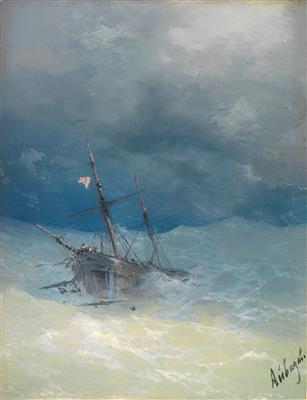Ivan Konstantinovich Aivazovsky

(Feodosia 1817–1900)
Sinking Ship, signed in Cyrillic script, also inscribed and dated 1889 in the artist’s own hand in Cyrillic script on the reverse, oil on mahogany, 26.9 x 20.6 cm, framed, (Rei)
Catalogued and illustrated in:
Light, Water and Sea, the paintings of Ivan Aivazovsky, by Gianni Caffiero and Ivan Samarine, London 2012, p.221, no.154.
Exhibited:
Sotheby’s, Ivan Aivazovsky, Exceptional works from a Private Collection 25–28 November 2012.
Provenance: Christie’s London, 30.11.2005, lot 100;
European private collection
We are grateful to Gianni Caffiero for his confirmation of authenticity with reference to the original.
Shipwrecks and ships sailing amidst a storm were popular motifs in nineteenth century European painting. Ivan Aivazovsky was born into a period of extensive change in Western Europe. Developments in science, medicine, education, communication and transport were revolutionising the way people lived their lives, faster and more irrevocably than ever before.
The mood was optimistic and accompanied by faith in human achievement. It was also the age of nationalism and colonialism, rising wealth, booming industry and increasing exploitation of natural resources.
The 19th century gave birth to a growing middle class with the education and means for a cultural life. It was during this period that galleries, museums, concert halls and opera houses first opened to the public.
It was in this context of international change that Ivan Aivazovsky began his career as marine painter.
Born in Theodosia, a port on the Black Sea, Aivazovsky displayed artistic ability from a very early age and later studied under the landscapist Maxim Nikiforovich Vorobiov (1787–1855) at the St Petersburg Academy of Arts. He quickly established a certain reputation for his masterful seascapes which combined delicate tonal harmony with an almost fantastic beauty. He was captivated by the sea. He painted it in all weathers and light: in calm and storm, by day and night.
Like many young Russian painters of his generation, Ivan Aivazovsky was deeply influenced by the plein air technique of Sylvester Shchedrin (1791–1830).
He visited Italy in the second half of 1840 during a study tour, motivated by the hope of discovering the artistic secrets of Shchedrin who had lived in Naples and Rome.
Shchedrin had indeed managed to break with the academic tradition in the 1820s. He painted en plein air views of Naples which were not only true to nature but also filled with a poetic sensibility.
However, Aivazovsky was not entirely satisfied with Shchedrin’s perception of nature and abandoned plein air painting after this trip, preferring to work from pencil sketches. From this time onwards he worked not from nature, but from memory.
Shipwrecks and ships sailing amidst a storm were popular motifs in nineteenth century European painting. The artist would repeatedly return to these subjects throughout his life.
Esperta: Mag. Dimitra Reimüller
 Mag. Dimitra Reimüller
Mag. Dimitra Reimüller
+43-1-515 60-355
19c.paintings@dorotheum.at
23.04.2015 - 18:00
- Prezzo realizzato: **
-
EUR 106.250,-
- Stima:
-
EUR 50.000,- a EUR 60.000,-
Ivan Konstantinovich Aivazovsky
(Feodosia 1817–1900)
Sinking Ship, signed in Cyrillic script, also inscribed and dated 1889 in the artist’s own hand in Cyrillic script on the reverse, oil on mahogany, 26.9 x 20.6 cm, framed, (Rei)
Catalogued and illustrated in:
Light, Water and Sea, the paintings of Ivan Aivazovsky, by Gianni Caffiero and Ivan Samarine, London 2012, p.221, no.154.
Exhibited:
Sotheby’s, Ivan Aivazovsky, Exceptional works from a Private Collection 25–28 November 2012.
Provenance: Christie’s London, 30.11.2005, lot 100;
European private collection
We are grateful to Gianni Caffiero for his confirmation of authenticity with reference to the original.
Shipwrecks and ships sailing amidst a storm were popular motifs in nineteenth century European painting. Ivan Aivazovsky was born into a period of extensive change in Western Europe. Developments in science, medicine, education, communication and transport were revolutionising the way people lived their lives, faster and more irrevocably than ever before.
The mood was optimistic and accompanied by faith in human achievement. It was also the age of nationalism and colonialism, rising wealth, booming industry and increasing exploitation of natural resources.
The 19th century gave birth to a growing middle class with the education and means for a cultural life. It was during this period that galleries, museums, concert halls and opera houses first opened to the public.
It was in this context of international change that Ivan Aivazovsky began his career as marine painter.
Born in Theodosia, a port on the Black Sea, Aivazovsky displayed artistic ability from a very early age and later studied under the landscapist Maxim Nikiforovich Vorobiov (1787–1855) at the St Petersburg Academy of Arts. He quickly established a certain reputation for his masterful seascapes which combined delicate tonal harmony with an almost fantastic beauty. He was captivated by the sea. He painted it in all weathers and light: in calm and storm, by day and night.
Like many young Russian painters of his generation, Ivan Aivazovsky was deeply influenced by the plein air technique of Sylvester Shchedrin (1791–1830).
He visited Italy in the second half of 1840 during a study tour, motivated by the hope of discovering the artistic secrets of Shchedrin who had lived in Naples and Rome.
Shchedrin had indeed managed to break with the academic tradition in the 1820s. He painted en plein air views of Naples which were not only true to nature but also filled with a poetic sensibility.
However, Aivazovsky was not entirely satisfied with Shchedrin’s perception of nature and abandoned plein air painting after this trip, preferring to work from pencil sketches. From this time onwards he worked not from nature, but from memory.
Shipwrecks and ships sailing amidst a storm were popular motifs in nineteenth century European painting. The artist would repeatedly return to these subjects throughout his life.
Esperta: Mag. Dimitra Reimüller
 Mag. Dimitra Reimüller
Mag. Dimitra Reimüller
+43-1-515 60-355
19c.paintings@dorotheum.at
|
Hotline dell'acquirente
lun-ven: 10.00 - 17.00
kundendienst@dorotheum.at +43 1 515 60 200 |
| Asta: | Dipinti del XIX secolo |
| Tipo d'asta: | Asta in sala |
| Data: | 23.04.2015 - 18:00 |
| Luogo dell'asta: | Wien | Palais Dorotheum |
| Esposizione: | 11.04. - 23.04.2015 |
** Prezzo d'acquisto comprensivo di tassa di vendita e IVA
Non è più possibile effettuare un ordine di acquisto su Internet. L'asta è in preparazione o è già stata eseguita.
